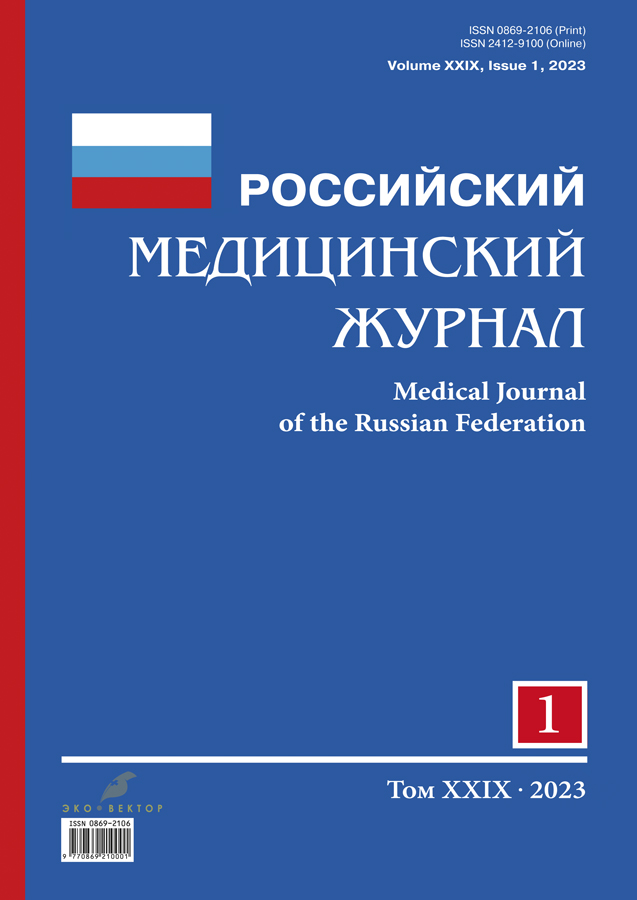Role of monocytes in the development of psychovegetative disorders in young people with undifferentiated connective tissue dysplasia
- 作者: Malceva I.V.1, Sheremetieva I.I.1, Kotovshchikova E.F.1, Selezneva A.A.1, Buylova E.V.1
-
隶属关系:
- Altai State Medical University
- 期: 卷 29, 编号 1 (2023)
- 页面: 5-16
- 栏目: Original Research Articles
- ##submission.dateSubmitted##: 31.01.2023
- ##submission.dateAccepted##: 06.02.2023
- ##submission.datePublished##: 23.02.2023
- URL: https://medjrf.com/0869-2106/article/view/163238
- DOI: https://doi.org/10.17816/medjrf163238
- ID: 163238
如何引用文章
详细
Background: The immune system plays an important role in the development of neuropathology. Dysfunction of monocytes/macrophages can contribute to environmental health and the development of neuroinflammatory and neurodegenerative diseases. Two subpopulations of monocytes are distinguished, namely, anti-inflammatory and activated pro-inflammatory monocytes, producing cytokines interleukin (IL)-1, IL-6, IL-2, IL-8, and tumor necrosis factor (TNF)-α, which are involved in immune inflammation in mental diseases. Violations of cellular, phagocytic, and/or humoral immunity are often found in patients with undifferentiated connective tissue dysplasia (UCTD). Monocytes are assumed to be involved in the development of psychovegetative disorders in patients and connective tissue insufficiency.
Aim: To study the relationship between the number of monocytes and pro-inflammatory cytokines (IL-1, IL-6, and TNF-α) in the peripheral blood with possible non-psychotic diseases and autonomic dysfunction syndrome in UCTD in young people.
Materials and methods: We examined 95 people aged 18–22 years. Neuropsychological examination, general clinical blood tests, pro-inflammatory cytokines (IL-1, IL-6, TNF-α), markers of neurodegeneration (neuron-specific enolase) and cerebral ischemia (antibodies to NR2) were sent.
Results: An increase in the absolute monocyte count in the peripheral blood is accompanied by a lesser severity of psychovegetative, ischemic, and neurodegenerative cases. An inverse correlation was found between the level of monocytes in the peripheral blood and the number of UCTD indicators, a direct correlation between UCTD and autonomic dysfunction syndrome (ADS), asthenic condition, personal anxiety, depression, neurosis, Internet addiction, and headache research index for everyday life. Severe UCTD leads to a change in the proportion of monocytes in the use of the pro-inflammatory subpopulation, which is probably one of the reasons for the numerous non-psychotic diseases and autonomic nervous system diseases in these patients.
Conclusion: An increase in the pro-inflammatory monocyte count in severe UCTD plays an important role in the development of psychovegetative disorders. The correction of the dysplastic process can become an important role in the prevention and detection of various neurological and non-psychotic diseases, such as ADS and anxiety–depressive syndrome in young people.
全文:
作者简介
Irina Malceva
Altai State Medical University
编辑信件的主要联系方式.
Email: ibogd2009@rambler.ru
ORCID iD: 0000-0002-4247-2052
assistant lecturer
俄罗斯联邦, 40, Lenina avenue, 656038, BarnaulIrina Sheremetieva
Altai State Medical University
Email: rector@agmu.ru
ORCID iD: 0000-0001-8513-9869
SPIN 代码: 8805-6940
MD, Dr. Sci. (Med.), professor
俄罗斯联邦, 40, Lenina avenue, 656038, BarnaulElena Kotovshchikova
Altai State Medical University
Email: kotov-l@mail.ru
ORCID iD: 0000-0002-3246-5609
SPIN 代码: 6358-0981
MD, Dr. Sci. (Med.), professor
俄罗斯联邦, 40, Lenina avenue, 656038, BarnaulAnastasia Selezneva
Altai State Medical University
Email: selezneva.doc99@mail.ru
ORCID iD: 0000-0002-1342-1125
student
俄罗斯联邦, 40, Lenina avenue, 656038, BarnaulEvgenia Buylova
Altai State Medical University
Email: 693003@list.ru
ORCID iD: 0000-0002-5647-8105
MD, Cand. Sci. (Med.), associate professor
俄罗斯联邦, 40, Lenina avenue, 656038, Barnaul参考
- Vasilyeva EF, Brusov OS. The role of monocytes cellular and molecular mechanisms in the development of systemic immune inflammation. Part 1. Psychiatry (Moscow). 2020;18(3):76–85. (In Russ). doi: 10.30629/2618-6667-2020-18-3-76-85
- Vasilyeva EF, Brusov OS. Сellular and molecular mechanisms of proinflammatory monocytes participation in the pathogenesis of mental disorders. Part 2. Psychiatry (Moscow). 2020;18(4):81–92. (In Russ). doi: 10.30629/2618-6667-2020-18-4-81-92
- Vasilyeva EF, Sekirina TP, Sarmanova ZV, et al. Estimation of level of subpopulation CD14+, CD16+ monocytes in patients with juvenile depressions. Medical Immunology (Russia). 2019;21(2): 257–258. (In Russ). doi: 10.15789/1563-0625-2019-2-257-268
- Merino A, Buendia P, Martin-Malo A, et al. Senescent CD14+, CD16+ monocytes exhibit proinflammatory and proatherosclerotic activity. J Immunol. 2011;186(3):1809–1815. doi: 10.4049/jimmunol.1001866
- Strauss-Ayali D, Conrad SM, Mosser DM. Monocyte subpopulations and their differentiation patterns during infection. J Leukoc Biol. 2007;82(2):244–252. doi: 10.1189/jlb.0307191
- Theodoropoulou S, Spanakos G, Baxevanis CN, et al. Cytokine serum levels, autologous mixed lymphocyte reaction and surface marker analysis in never medicated and chronically medicated schizophrenic patients. Schizophr Res. 2001;47(1):13–25. doi: 10.1016/s0920-9964(00)00007-4
- Takahashi V, Yu Z, Sakai M, Tomita H. Linking activation of microglia and peripheral monocytic cells to the pathophysiology of psychiatric disorders. Front Cell Neurosci. 2016;10:144. doi: 10.3389/fncel.2016.00144
- Talarowska M, Szemraj J, Gałecki P. The role of interleukin genes in the course of depression. Open Med (Wars). 2016;11(1):41–48. doi: 10.1515/med-2016-0009
- Aleshkina GA, Bardenshtejna LM. Ostrye i prehodjashhie psihoticheskie rasstrojstva. ID «Medpraktika-M»; 2017. 180 p. (In Russ).
- Undifferentiated connective tissue dysplasia (the project of guidelines). Therapy. 2019;5(7):9–42. (In Russ). doi: 10.18565/therapy.2019.7.9-42
- Nechaykina SA, Malmberg SA, Petrukhin AS. Neurologic disorders associated with dysplasia of connective tissue in children and their correction. Russian Journal of Child Neurology. 2010;5(3):11–20. (In Russ).
- Alekseeva OS, Kirik OV, Gilerovich EG, Korzhevskii DE. Microglia of the brain: origin, structure and functions. Zhurnal evolyutsionnoi biokhimii i fiziologii. 2019;55(4):231–241. (In Russ). doi: 10.1134/S0044452919040028
- Gogoleva VS, Drutskaya MS, Atretkhany KS-N. The role of microglia in the homeostasis of the central nervous system and neuroinflammation. Molecular Biology. 2019;53(5):696–703. (In Russ). doi: 10.1134/S0026898419050057
- Nikiforova (Postnikova) TA, Peskov SA, Doronina OB. Analysis of the modern status of clinical and experimental data about interaction between nervous and immune systems. Bulletin of Siberian Medicine. 2014;13(6):72–80. (In Russ).
- Zhao M, Tuo H, Wang S, Zhao L. The roles of monocyte and monocyte-derived macrophages in common brain disorders. Biomed Res Int. 2020;2020:9396021. doi: 10.1155/2020/9396021
- Chernykh ER, Shevela EY, Ostanin AA. The role of macrophages in damage recovery of central nervous system: new options for treatment of neurological disorders. Medical Immunology (Russia). 2017;19(1):7–18. (In Russ). doi: 10.15789/1563-0625-2017-1-7-18
- Sakhno LV, Shevela EYa, Chernykh ER. Phenotypic and functional characteristics of the alternative activated macrophages: potential use in regenerative medicine. Immunologiya. 2015;36(4): 242–246. (In Russ).
补充文件









